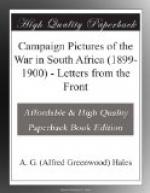Slowly but steadily they rolled onward, like a great sluggish, but irresistible, yellow wave, until we saw the scouts slipping from rock to rock up the stony heights of the first line of hills. Breathlessly we watched the intrepid “eyes of the army” advance until they stood silhouetted against the sky-line on the top of the black bulwarks of the veldt. Then we strained our ears to catch the rattle of the enemy’s rifles, but we listened in vain; and we were completely staggered. What did it mean? Was it a trap? Was there some devilish craft behind that apparent peacefulness? Trap or no trap, we had not long to wait. The long, yellow wave curled inwards from both flanks, the men going forward with quick, lithesome steps. The mounted infantry shot forward as if moved by magic, and, before the eye could scarcely grasp the details, our fellows held the heights, and men marvelled and wondered whether the Boers had bolted for good. But they soon undeceived us, for the hills shook with the far-reaching roar of their guns, and shells began to make melody which devils love; but they did no harm. Not a man was touched. Then came the short, sharp word of command from our lines. Officers bit their words across the centre, and threw them at the men. The Horse Artillery moved into position, some going at a steady trot, others sweeping along the valleys as if they were the children of the storm. The left flank swung forward and encircled the base of an imposing kopje. The men swarmed up with tiger-like activity, quickly, and in broken and irregular lines; but there was no confusion, no wretched tangle, no helpless muddle. They did not rush madly to the top and stand on the sky-line to be a mark for their foes. When they almost touched the summit they paused, formed their broken lines, and carefully and wisely topped the black brow; and as they did so the Boer rifles spoke from a line of kopjes that lay behind the first. Then our fellows dropped to cover, and sent an answer back that a duller foe than the Boers would not have failed to understand. The Mauser bullets splashed on the rocks, and spat little fragments of lead in all directions; but few of them found a resting-place under those thin yellow jackets. By-and-by the shells began to follow the Mauser’s spiteful pellets, but the shells were less harmful even than the little hostile messengers; for, though well directed, the shells never burst—they simply shrieked, yelled, and buried themselves. Our gunners got the ground they wanted, and soon gun spoke to gun in their deep-throated tones of defiance. The Boers were not hurting us; whether we were injuring them we could not tell.




